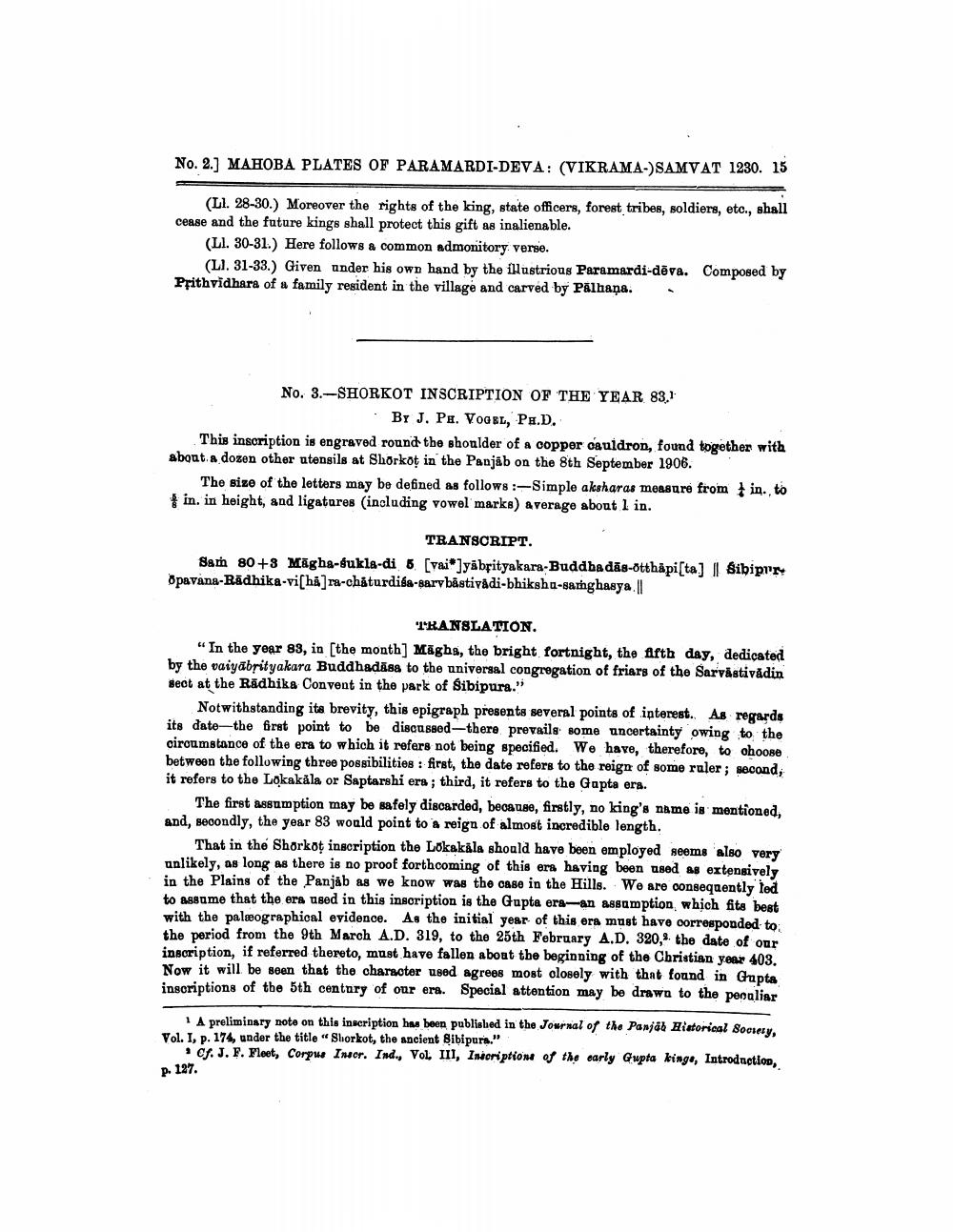________________
No. 2.] MAHOBA PLATES OF PARAMARDI-DEVA: (VIKRAMA-)SAMVAT 1230. 15
(Ll. 28-30.) Moreover the rights of the king, state officers, forest tribes, soldiers, etc., shall cease and the future kings shall protect this gift as inalienable.
(Ll. 30-31.) Here follows a common admonitory verse.
(Ll. 31-33.) Given under his own hand by the illustrious Paramardi-deva. Composed by Prithvidhara of a family resident in the village and carved by Palhana.
No. 3.-SHORKOT INSCRIPTION OF THE YEAR 83,1
By J. PH. VOGEL, PH.D.
This inscription is engraved round the shoulder of a copper cauldron, found together with about a dozen other utensils at Shorkot in the Panjab on the 8th September 1906.
The size of the letters may be defined as follows:-Simple aksharas measure from in., to in. in height, and ligatures (including vowel marks) average about 1 in.
TRANSCRIPT.
Sam 80+3 Magha-sukla-di 5 [vai*]yäbrityakara-Buddha das-otthäpi[ta] | Sibipur opavana-Radhika-vi[há]ra-chaturdisa-sarvbastivadi-bhikshu-samghasya.||
TRANSLATION.
"In the year 83, in [the month] Maghs, the bright fortnight, the fifth day, dedicated by the vaiyabṛityakara Buddhadass to the universal congregation of friars of the Sarvästivädin sect at the Radhika Convent in the park of Sibipura."
Notwithstanding its brevity, this epigraph presents several points of interest. As regards its date the first point to be discussed-there prevails some uncertainty owing to the circumstance of the era to which it refers not being specified. We have, therefore, to choose. between the following three possibilities: first, the date refers to the reign of some ruler; second, it refers to the Lokakala or Saptarshi ers; third, it refers to the Gapta era.
The first assumption may be safely discarded, because, firstly, no king's name is mentioned, and, secondly, the year 83 would point to a reign of almost incredible length.
That in the Shorkot inscription the Lokakala should have been employed seems also very unlikely, as long as there is no proof forthcoming of this era having been used as extensively in the Plains of the Panjab as we know was the case in the Hills. We are consequently led to assume that the era used in this inscription is the Gupta era-an assumption, which fits best with the paleographical evidence. As the initial year of this era must have corresponded to the period from the 9th March A.D. 319, to the 25th February A.D. 320, the date of our inscription, if referred thereto, must have fallen about the beginning of the Christian year 403. Now it will be seen that the character used agrees most closely with that found in Gupta inscriptions of the 5th century of our era. Special attention may be drawn to the peculiar
1 A preliminary note on this inscription has been published in the Journal of the Panjab Historical Society, Vol. I, p. 174, under the title "Shorkot, the ancient Sibipura."
Cf. J. F. Fleet, Corpus Insor. Ind., Vol. III, Inscriptions of the early Gupta kings, Introduction,
p. 127.




